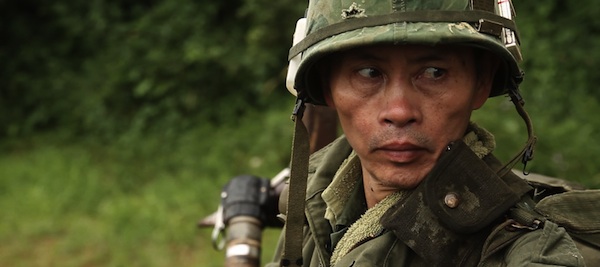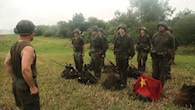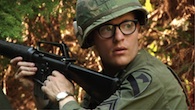 Sergeant Vinh Nguyen, who served with the 25th Division, Army of the Republic of Vietnam (ARVN), is part of the group that reenacts Vietnam War missions. The group is the focus of a new documentary, In Country.
Sergeant Vinh Nguyen, who served with the 25th Division, Army of the Republic of Vietnam (ARVN), is part of the group that reenacts Vietnam War missions. The group is the focus of a new documentary, In Country.
In Country opens with men in 1960s green US Army uniforms sitting in an orientation session. Then they are shown in a mission briefing, going over maps and taking notes. Soon, they are moving stealthily through tall grass and woods. They ford streams, M16s at the ready, watchful for what may be on the other side. It is very easy to believe this is a documentary about the Vietnam War, but these woods and streams are in the Northwestern United States, not in Southeast Asia. This documentary is about Delta 2/5(R), a group of men who get together to reenact Vietnam War missions.
Many Americans are familiar with Civil War reenactments or the medieval combat staged by the Society for Creative Anachronism. There are also reenactments groups for World War II and other eras. All of these groups participate in “closed” reenactments, tactical operations that are not open to the public, but also put on what were called “sham battles” in the 19th century, in which crowds of onlookers can watch the battle tactics of past wars play out before their eyes.
The crowds are absent at these Vietnam War reenactments; the public is never invited.
The men are given classes about Vietnam War–era slang and events that were happening “back in the world” while the war was going on, such as the Peace and Love movement. In the field, they talk as if they are in the jungles stalking Viet Cong, and they exhibit real-world battlefield tactics. During the weekend, some of them will take on the role of the VC—you can’t fight a war if the other side doesn’t show up. Scenarios are planned in advance, e.g., “Tomorrow afternoon you will engage us but then break contact. Tomorrow night we’ll be setting up here.”
Determining when you are “hit” in other reenactments is often a matter of when you feel hot and tired enough that you’d rather lie in the shade as a casualty. In the Vietnam reenactments, each man is given a casualty card that tells him what effect the hit had (“fragment wound, left forearm; you can walk and talk”). The wounded have to be carried to an evacuation point.
“Don’t just die,” they are told, “unless you see a muzzle pointed directly at you and you are sitting up—something like that.” There are no “large pools of dead guys sitting around smoking cigarettes.”
So why are they doing this? That’s a question all reenactors get, but perhaps it carries additional implications when the war being reenacted is one that remains controversial, a bitter memory for many Americans. The documentary tries to answer that question.
 The reenactors are there to honor America’s warriors—”We take great pride and love in the men that serve this country, especially the men that served in the Vietnam War”—but also to take part in a grown-up version of “playing war.”
The reenactors are there to honor America’s warriors—”We take great pride and love in the men that serve this country, especially the men that served in the Vietnam War”—but also to take part in a grown-up version of “playing war.”
Ultimately, each is there for his own reasons. One is a high school student who has already signed up to become a US Marine upon graduation. Some are veterans of Iraq and Afghanistan; some have never been in the military.
Joel Kinney, a Vietnam War equipment collector too young to have served in Southeast Asia, tells the assembled group of reenactors, “I had the privilege of being an Army kid. I remember Dad coming home from war. He’d have duffle bags full of gear … We could outfit nine kids in my neighborhood. We’d have battles in my back yard. We’d shoot bottle rockets out of launchers … We’re our dads’ kids. Most of our dads, our uncles were that age. Attach yourself to them.”
Another Kinney, Matt, says, “A lot of it is kind of a way to live out that childhood love of playing war in the woods … I always wanted to have experiences like that but not necessarily join the military.”
Army Staff Sergeant Lucien “Doc” Darensburg was a US Army Medic during two tours in Iraq, 2004-05 and 2009-10. He says of veterans, “It’s like a big brotherhood and these guys (the people who fought in Vietnam) are like a great-uncle or something … These stories are something I can relate to because I’ve been in a war—a different kind of war, but some of the feelings are the same.”
Hayden “Bummy” Baumgardner, an actual veteran of Vietnam, checks the men’s equipment before they go into the field to insure they are not carrying anything that wouldn’t have been carried during that war.
“When I came out (to the reenactments) in 2006,” he says, “for a couple of hours I went back (to Vietnam) … They treat me like a king.”
Baumgardner isn’t the only veteran of the war in Southeast Asia who takes part in these reenactments. Sergeant Vinh Nguyen served with the 25th Division, Army of the Republic of Vietnam (ARVN) during 1970-75. When an off-screen member of the film crew asks him why he does this, does it bring back bad memories, he responds:
First time I came to this troop, first time I hear gunfire I go back, go back, go back … I don’t exactly know why you said “bad memories.” (It was 36 years ago) but I am still whole now, I am still stronger than I was when I was with South Vietnam Army. I joined (the reenactment group) because I wanted to revisit my past, the image of what I was in the past.
We are the soldiers who for fought for freedom, side by side with the American soldiers. When returning to the past in my brain, my mind, I image some things like my father’s generation, my older brother’s generation, my own generation and those younger than me, what we all sacrificed in Vietnam. This group has given me the will to think about my homeland and to continue the struggle against the Vietnamese Communist Party in different ways.
The documentary, however, seems to want to do more than just explore why these men choose to participate in these reenactments, unseen by anyone but themselves. Presented by Oscar Alpha Mopic in association with Naked Edge Films, directed and produced by Mike Attie and Meghan O’Hara, In Country cuts back and forth between the reenactments, archival film footage from Vietnam, and footage from battlefields of the War on Terror. Unfortunately, this often makes for a muddled message. It is jarring to have been listening to talk about Vietnam and then see footage of the Iraq War. More jarring still is the juxtaposition of elements such as the reenactors bringing in two “Viet Cong prisoners,” followed by scenes of American soldiers actually searching a village during the war and capturing suspected VC while women and children cry in the background.
 An extended sequence covers Specialist Charles “Tuna” Ford, who served in Iraq with the US Army during 2008-09, and his family as they visit a military museum. He talks about his “crazy” spell (episodes of post-traumatic stress syndrome) that nearly led him and his wife to divorce. He talks about his dilemma of staying in the service where he will continue providing income and insurance for his family but he runs the risk of being killed. He says in the film, “It’s such a crazy high, just going out there, being out there. It’s like some people skateboard, some people ride fast bikes, some people shoot heroin. People ask me what I do. Well, I’m in the Army, and I go to war.”
An extended sequence covers Specialist Charles “Tuna” Ford, who served in Iraq with the US Army during 2008-09, and his family as they visit a military museum. He talks about his “crazy” spell (episodes of post-traumatic stress syndrome) that nearly led him and his wife to divorce. He talks about his dilemma of staying in the service where he will continue providing income and insurance for his family but he runs the risk of being killed. He says in the film, “It’s such a crazy high, just going out there, being out there. It’s like some people skateboard, some people ride fast bikes, some people shoot heroin. People ask me what I do. Well, I’m in the Army, and I go to war.”
Staff Sergeant Lucien Darensburg, the medic who did two tours of Iraq, also talks about what could be described as PTSD: “I’m still the same person. I smile a lot, I joke … but real emotions—happiness, sadness—it’s all surface emotions. I don’t know where the real emotions went.”
This is part of what will make In Country difficult for many viewers to decipher. Here are veterans of recent wars acknowledging their emotional scars, yet they enjoy going into the woods to reenact battles from another era. Darensburg is shown during a reenactment pulling a “wounded” comrade to safety. Many viewers will be asking, “Why on earth do you want to relive this?” People who reenact other eras may “get it,” but the general public is likely to struggle with this question, despite the film’s best efforts to have the Vietnam War reenactors explain their reasons.
While the documentary was being filmed, Specialist Charles “Tuna” Ford was deployed again, this time to Afghanistan. The film includes footage of him at Forward Base Wolverine there, and it concludes with his brigade coming home to the cheers and tears of their families. Sons of the returning soldiers are shown holding their fathers’ rifles while they pose for grandparents to take pictures. A “welcome home” parade, which includes a group of Civil War reenactors, honors the returning warriors. Earlier in the film Hayden Baumgardner talks about how, within hours of coming home from Vietnam, he took off his uniform and didn’t put it back on. He didn’t want people to know where he had just come from; he wanted to blend in. Ending the documentary with this celebration may be intended to contrast the heroes’ welcome Americans give to veterans of the War on Terror with the un-welcome Vietnam veterans received, but like other elements of the film, that is open to viewers’ interpretation.
At times, In Country seems like a documentary melded with a French art film in which viewers are left to figure out the message on their own. Sometimes it is difficult to distinguish whether scenes are from the reenactments or are archival footage. Is In Country showing us what warriors and their families sacrifice in service to their country? Is it celebrating veterans (and their families) as heroes, or is it showing us a group of guys who say they are honoring those veterans but in a way many viewers will find odd? What is the purpose of juxtaposing scenes of the horrors of real wars with scenes from the Vietnam reenactments? Why are there so many shots of kids playing with toy guns? Is it to connect the childhood affection for playing at war with the activities of the reenactors? No clear message comes through, and perhaps that is the intention—to lay out conflicting information and let viewers make up their own minds about what the film is saying. It is in some ways a disturbing film, but one you are unlikely to quickly forget; it would be best to view it with friends with whom you can afterward debate its message—or messages—and that is a rare quality in documentaries. It is worth watching, even if viewers do so only to hear the veterans’ stories.
In Country will open in theaters beginning April 10, 2015, and will launch on iTunes and other leading video-on-demand platforms April 28. For more information, including a list of theaters where the film will be showing, go to incountryfilm.com. Be forewarned the film’s dialogue includes strong language and ethnic slurs directed against the Viet Cong.




